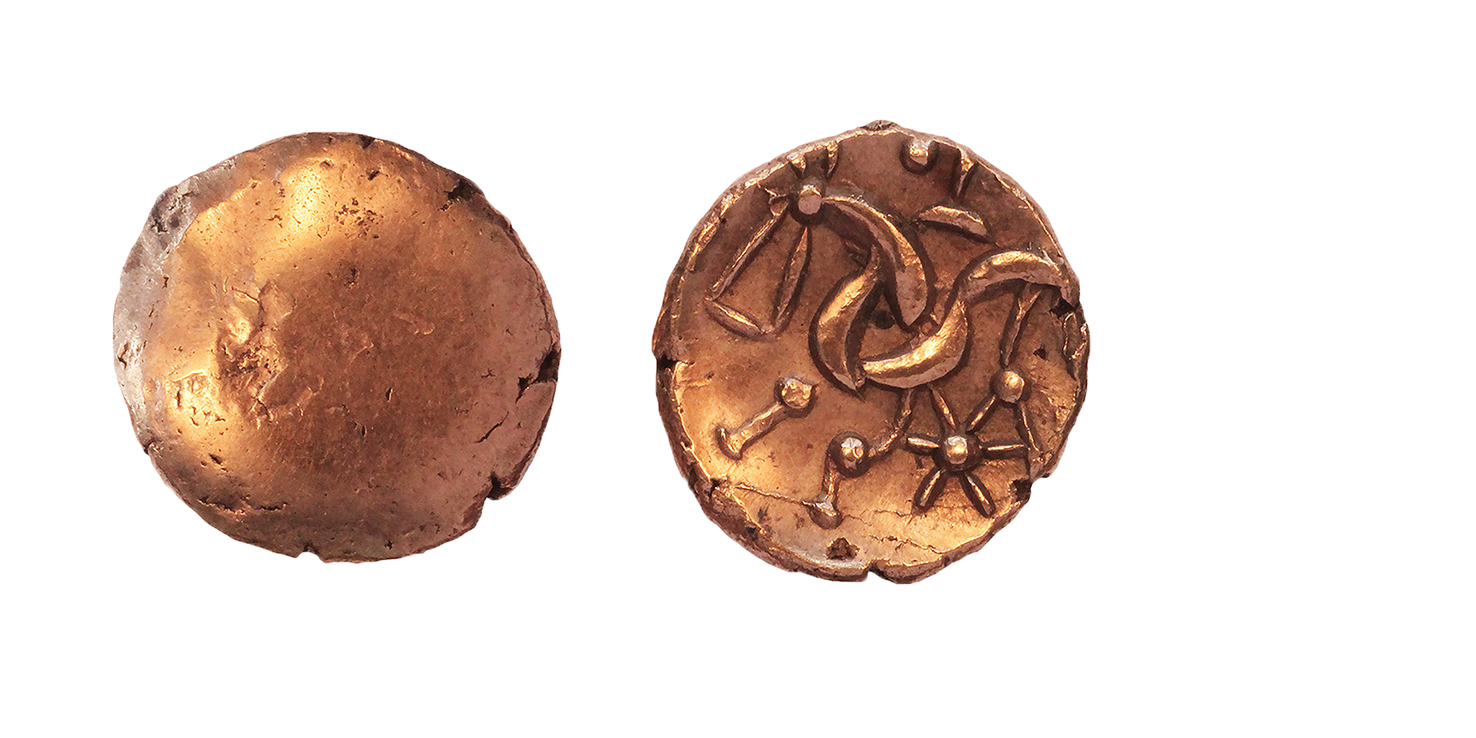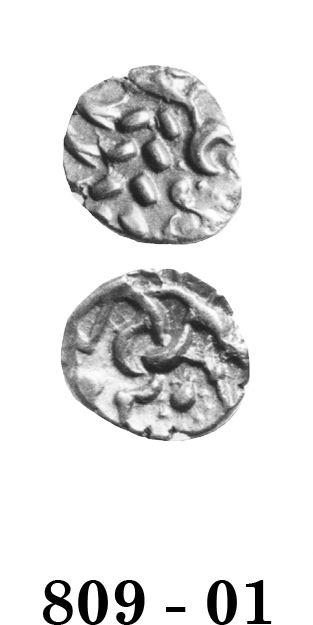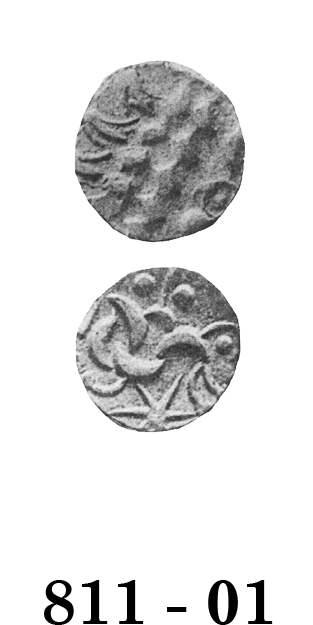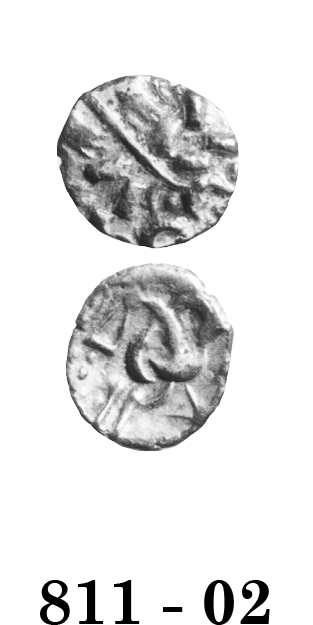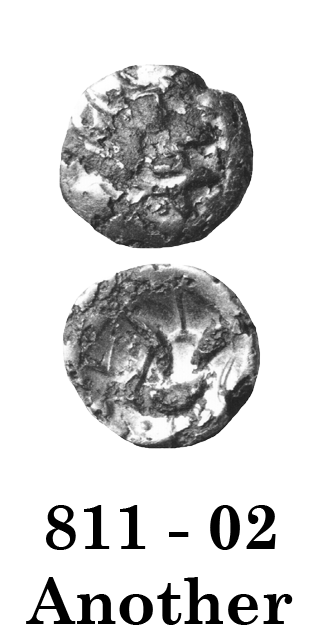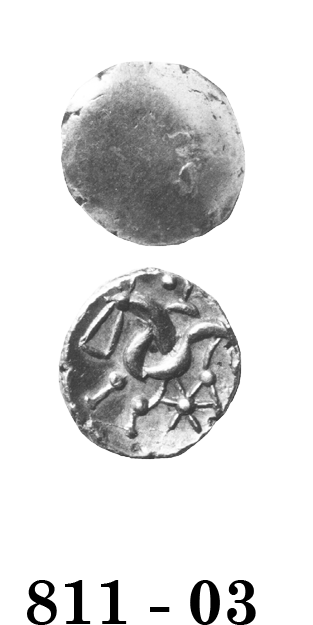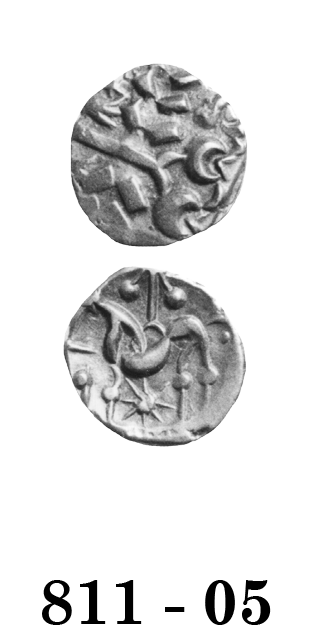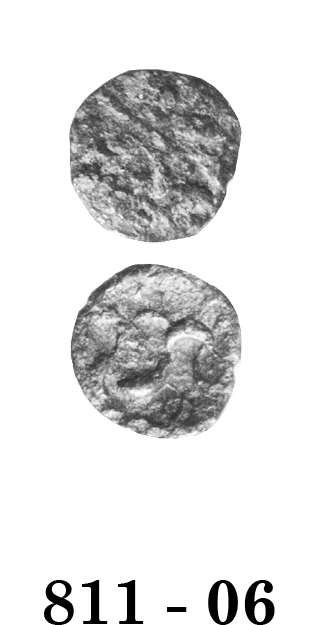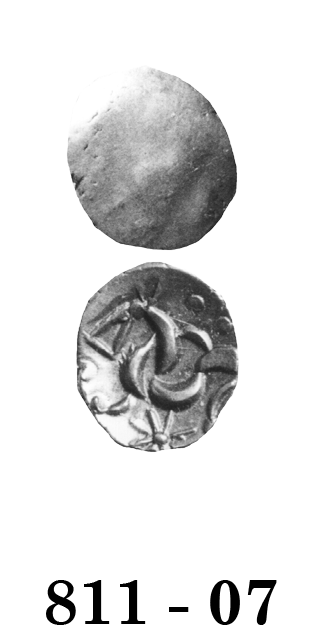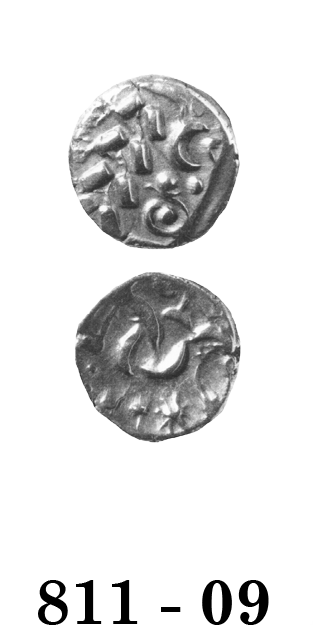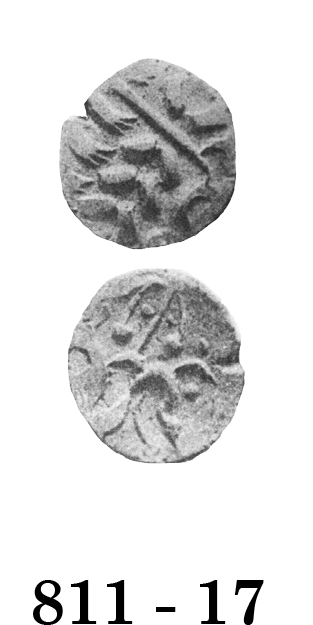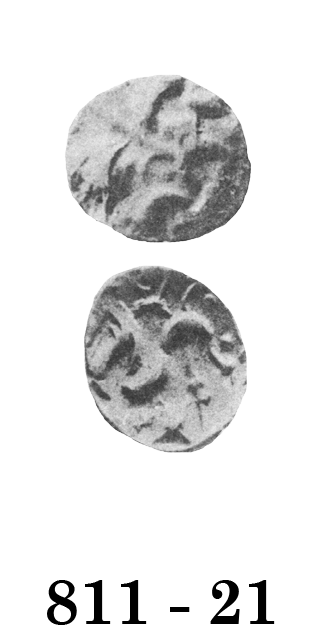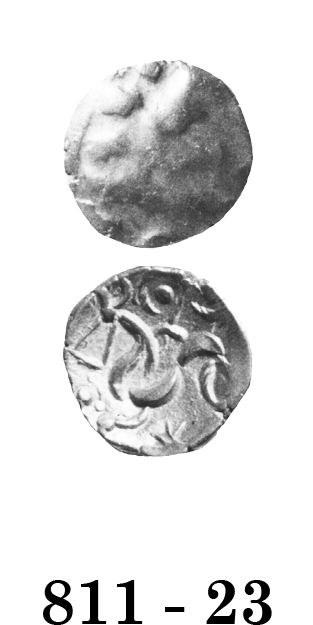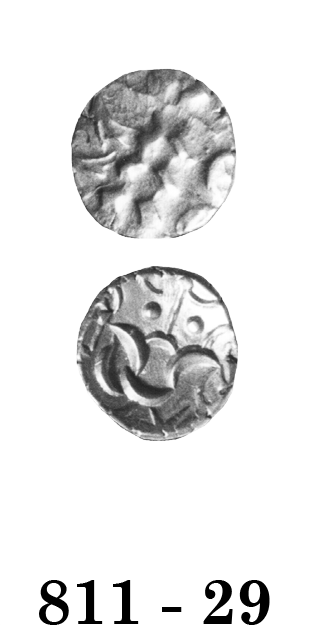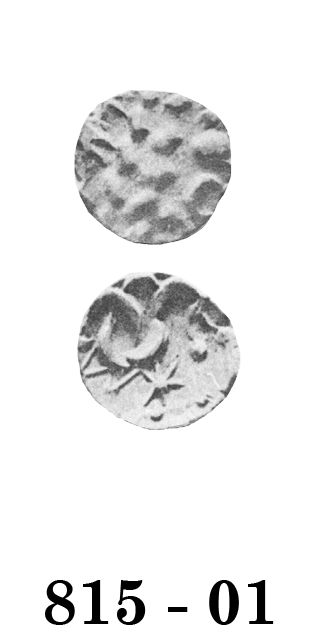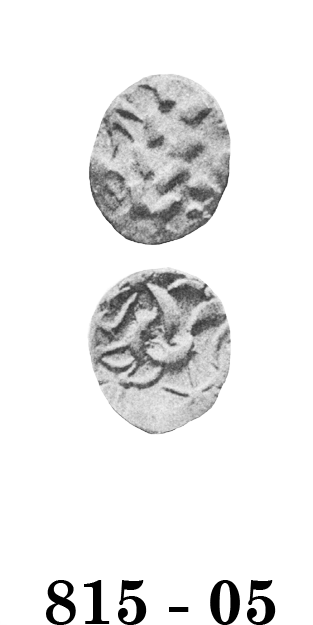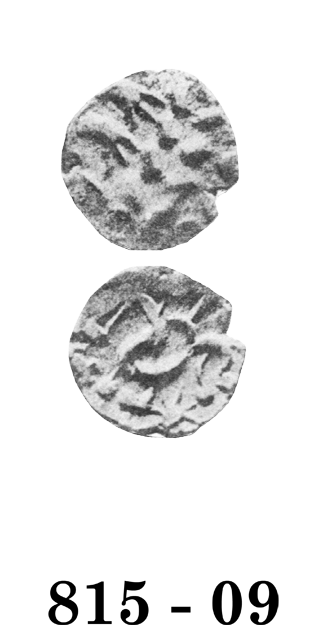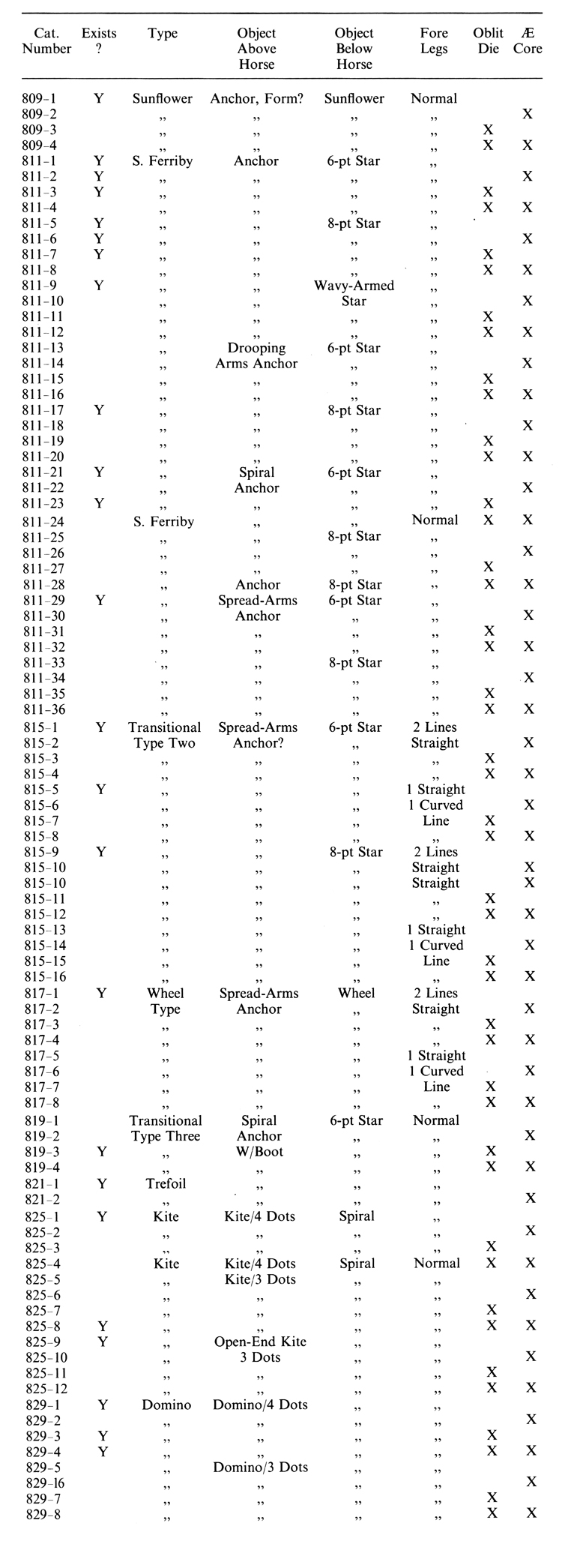
Celtic Coinage of Britain
third edition
Click on coin to see hidden information
South Ferriby Type Staters
In the past, several different varieties of coins were included under the South Ferriby Type. All had a highly stylized horse on the reverse, with variations in the ornaments in the field. The series is one of bewildering complexity and to make it more understandable, the term "South Ferriby Type" is now limited to only one variety, number 811. The other varieties have been renamed, basically according to the field ornaments.
The ornaments above the horse include variations of an anchor-like object; a rectangle with dots, which is now called a domino; and a lozenge-shaped box with pellets, which is now called a kite. Below the horse appear a six- or eight-pointed star, a wavy-armed star, a sunflower, or a spiral. The upper portions of the horse's front legs are either made up of a single line (the normal type); or two lines, either both straight, or one straight and one curved.
To add to the complexity, the obverse dies were often used until they were almost completely obliterated, yielding almost-uniface varieties. Coins made of bronze cores wrapped in gold foil are known for many types and the dies from which they were struck are competently engraved.
Consequently, when all these variations are combined, a tremendous number of types may be postulated. Many of these are not known to exist today; but many do, and others will probably appear in the future. Consequently, the following catalogue section has been constructed to accommodate the potential varieties. The accompanying table gives the catalogue numbers and descriptions, along with an indication of those types known to exist today.
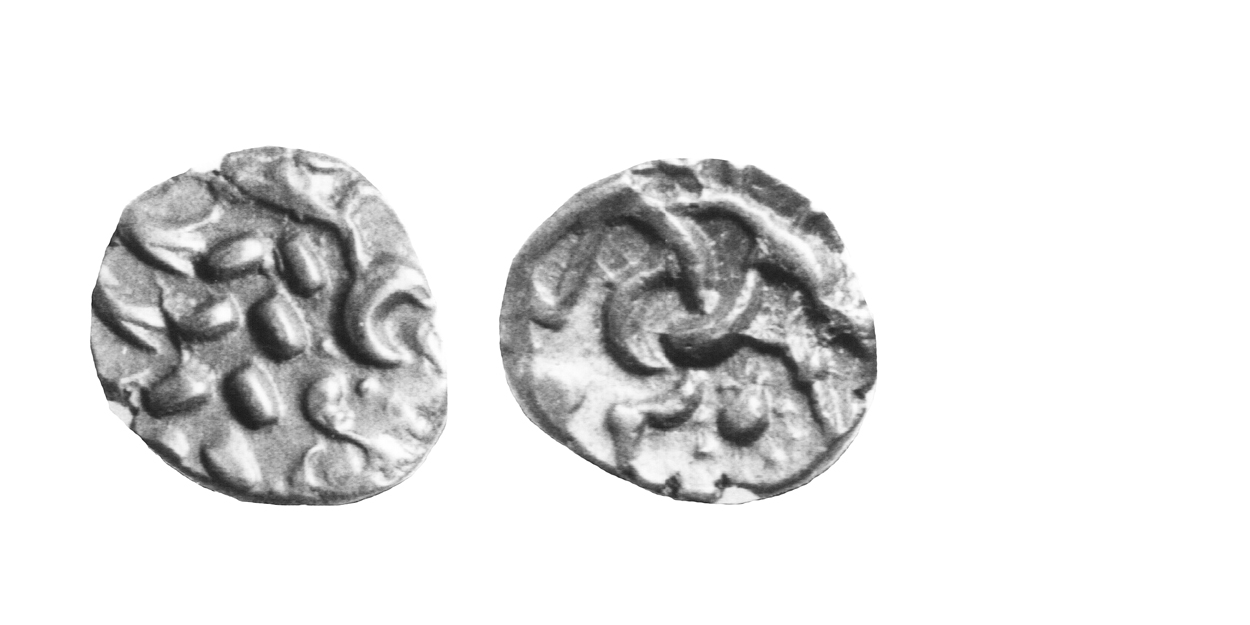
809 - 01 Sunflower Type
ca. 45-10 B.C. Rare
Gold Stater 5.2-5.7 gms. 19 mm
Earliest Record: Allen, 1960
OBV: Abstracted head of Apollo right
Identifying points:
1) spike with one crescent, end of spike may be bent to form two-pronged hook
2) wreath: leaves inwards
REV: Disjointed horse left
Identifying points:
1) sunflower below horse
CLASSIFICATION: Corieltauvian C
Notes:
- Celtic Coin Index records now list many more coins than in the past
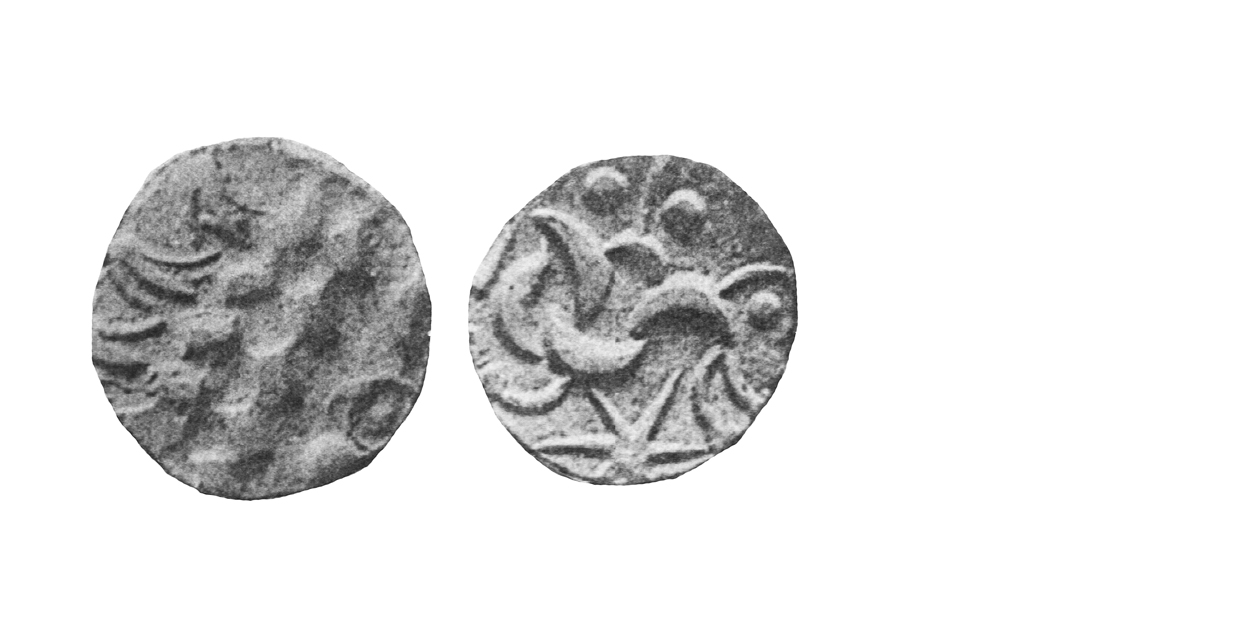
811 - 01 South Ferriby Type
ca. 45-10 B.C. Common
Gold Stater 5.2-5.7 gms. 18 mm
Earliest Record: Evans, 1864
OBV: Abstracted head of Apollo right
Identifying points:
1) spike with one crescent, end of spike may be bent to form two-pronged hook
2) wreath: leaves inwards
REV: Disjointed horse left
Identifying points:
1) pointed 'anchor' above horse
2) six-pointed star below horse
CLASSIFICATION: Corieltauvian D
NOTES:
- A variety with a four-pointed star is known, see 835 - 01
- Celtic Coin Index records now show many more coins than in the past
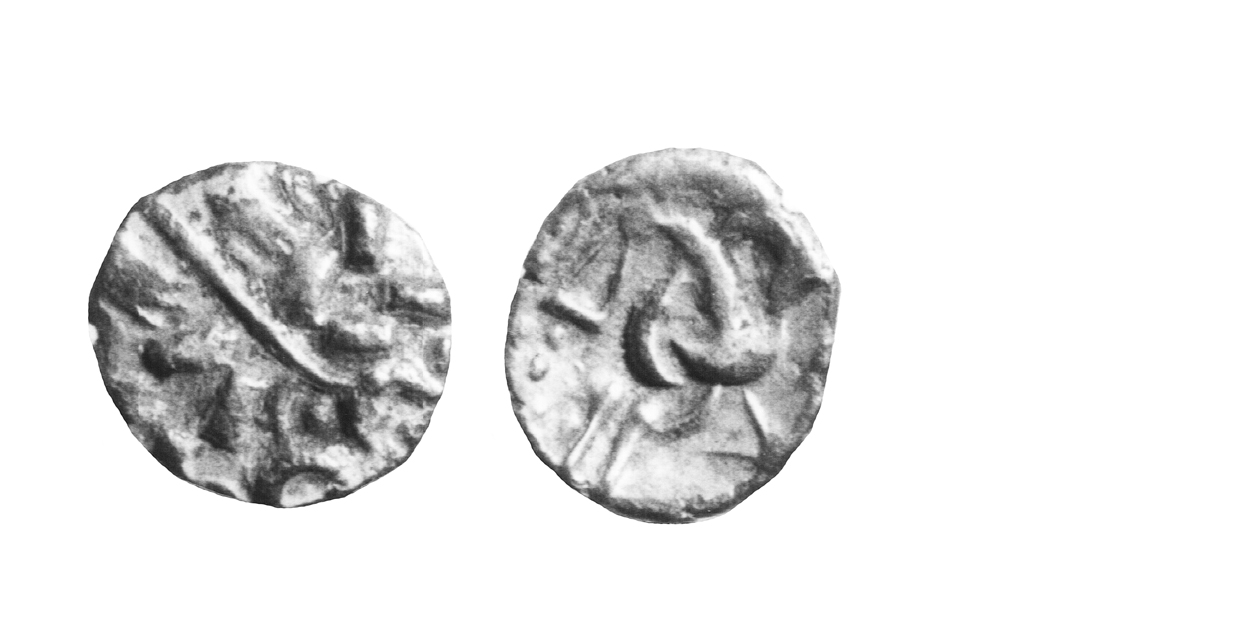
811 - 02 South Ferriby Type
ca. 45-10 B.C. Extremely Rare
Gold/Bronze Plated Stater ca. 4.7 gms. 19 mm
Earliest Record: Van Arsdell, 1989
OBV: Abstracted head of Apollo right
Identifying points:
1) spike with one crescent, end of spike may be bent to form two-pronged hook
2) wreath: leaves inwards
REV: Disjointed horse left
Identifying points:
1) pointed 'anchor' above horse
2) six-pointed star below horse
CLASSIFICATION: Corieltauvian D
NOTES:
- Bronze core of plated stater
- Ancient forgery of 811 – 01
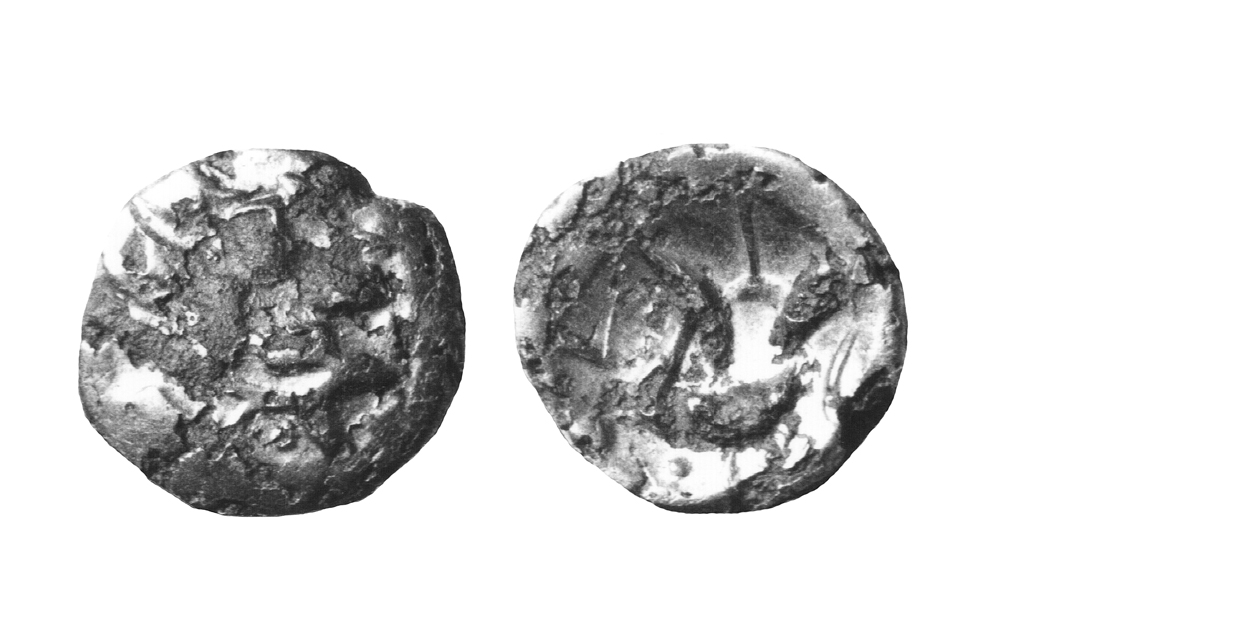
811 - 02 South Ferriby Type
ca. 45-10 B.C. Extremely Rare
Gold/Bronze Plated Stater ca. 4.7 gms. 19 mm
Earliest Record: Van Arsdell, 1989
OBV: Abstracted head of Apollo right
Identifying points:
1) spike with one crescent, end of spike may be bent to form two-pronged hook
2) wreath: leaves inwards
REV: Disjointed horse left
Identifying points:
1) pointed 'anchor' above horse
2) six-pointed star below horse
CLASSIFICATION: Corieltauvian D
NOTES:
- Bronze core of plated stater
- Ancient forgery of 811 – 01
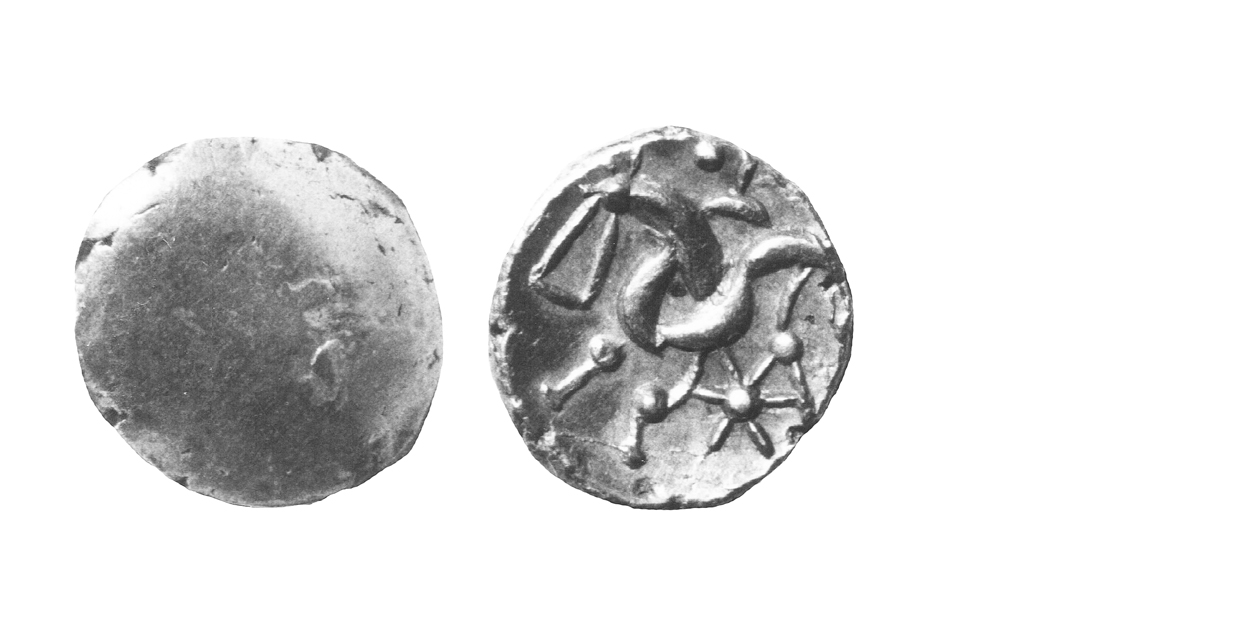
811 - 03 South Ferriby Type
ca. 45-10 B.C. Extremely Rare
Gold Stater 5.2-5.7 gms. 18 mm
Earliest Record: Evans, 1864
OBV: Abstracted head of Apollo right
Identifying points:
1) almost obliterated obverse die
REV: Disjointed horse left
Identifying points:
1) pointed 'anchor' above horse
2) six-pointed star below horse
CLASSIFICATION: Corieltauvian D
NOTES:
- Obverse die of 811 - 01 used until almost completely obliterated, some examples show almost a plain obverse
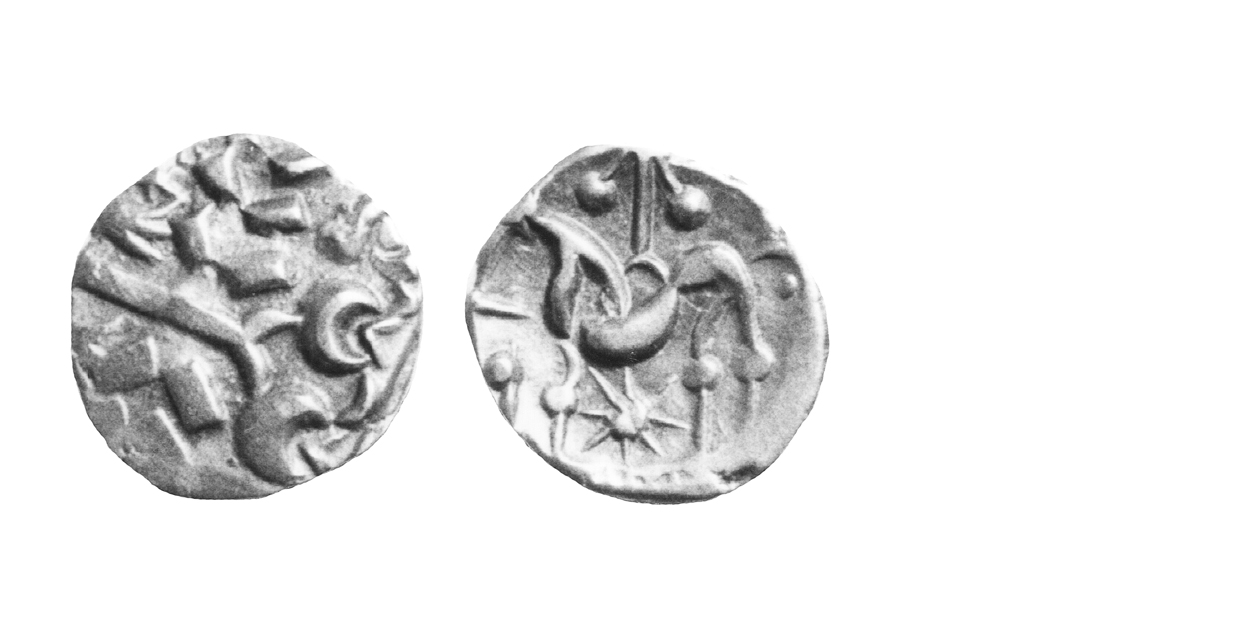
811 - 05 Ferriby Type
ca. 45-10 B.C. Scarce
Gold Stater 5.2-5.7 gms. 18 mm
Earliest Record: Poste, 1853
OBV: Abstracted head of Apollo right
Identifying points:
1) spike with one crescent, end of spike may be bent to form two-pronged hook
2) wreath: leaves inwards
REV: Disjointed horse left
Identifying points:
1) pointed 'anchor' above horse
2) eight-pointed star below horse
CLASSIFICATION: Corieltauvian D
Notes:
- Celtic Coin Index suggests this type could be rarer than indicated, but records usually do not identify exact die variety
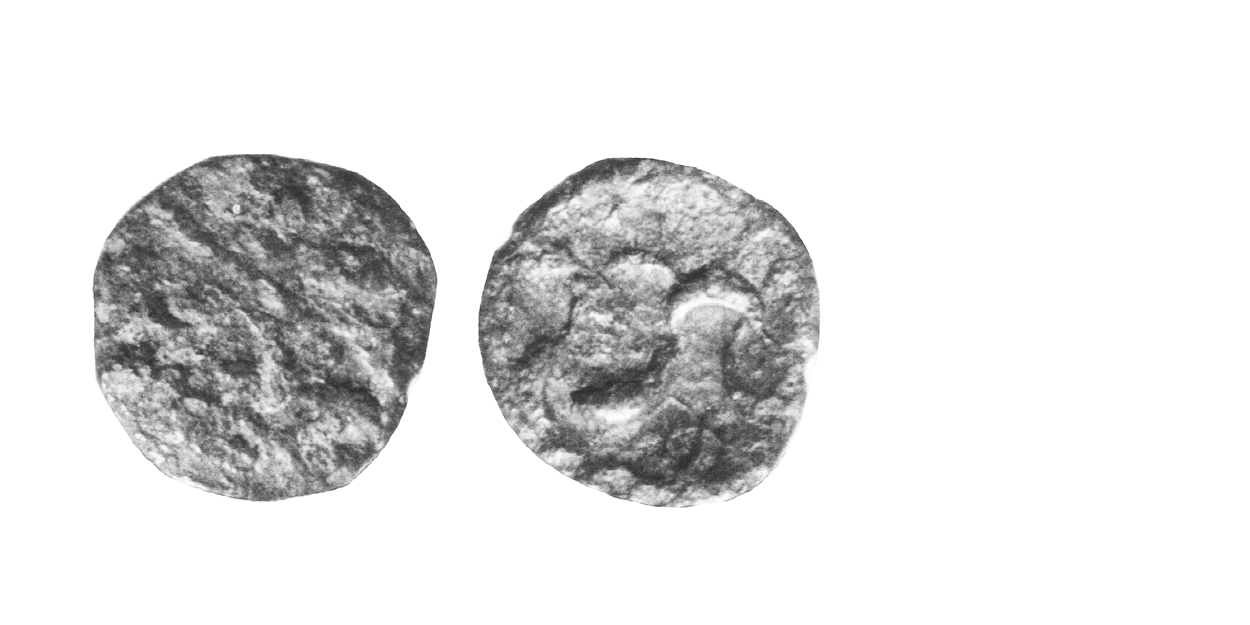
811 - 06 South Ferriby Type
ca. 45-10 B.C. Extremely Rare
Gold/Bronze Plated Stater ca. 4.1 gms. 18 mm
Earliest Record: Van Arsdell, 1989
OBV: Abstracted head of Apollo right
Identifying points:
1 spike with one crescent, end of spike may be bent to form two-pronged hook
2) wreath: leaves inwards
REV: Disjointed horse left
Identifying points:
1) pointed 'anchor' above horse
2) eight-pointed star below horse
CLASSIFICATION: Corieltauvian D
NOTES:
- Bronze core of plated stater
- Ancient forgery of 811 – 05
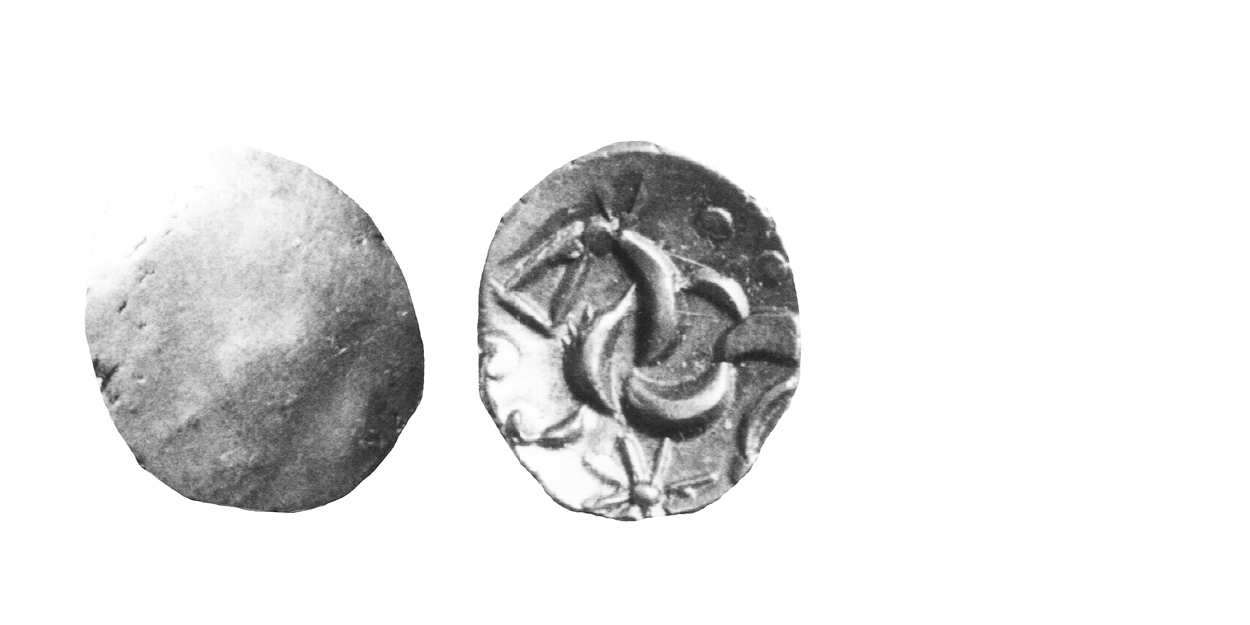
811 - 07 South Ferriby Type
ca. 45-10 B.C. Extremely Rare
Gold Stater 5.2-5.7 gms. 19 mm
Earliest Record: Roth, 1908 (South Ferriby Hoard)
OBV: Abstracted head of Apollo right
Identifying points:
1) almost obliterated obverse die
REV: Disjointed horse left
Identifying points:
1) pointed 'anchor' above horse
2) eight-pointed star below horse
CLASSIFICATlON: Corieltauvian D
NOTES:
- Obverse die of 811 - 05 used until almost completely obliterated some examples show almost a plain obverse
- Allen'63 Coritani Sylloge number 65 has seven-pointed star, but this is considered to be a die-cutting error, see 837 - 03
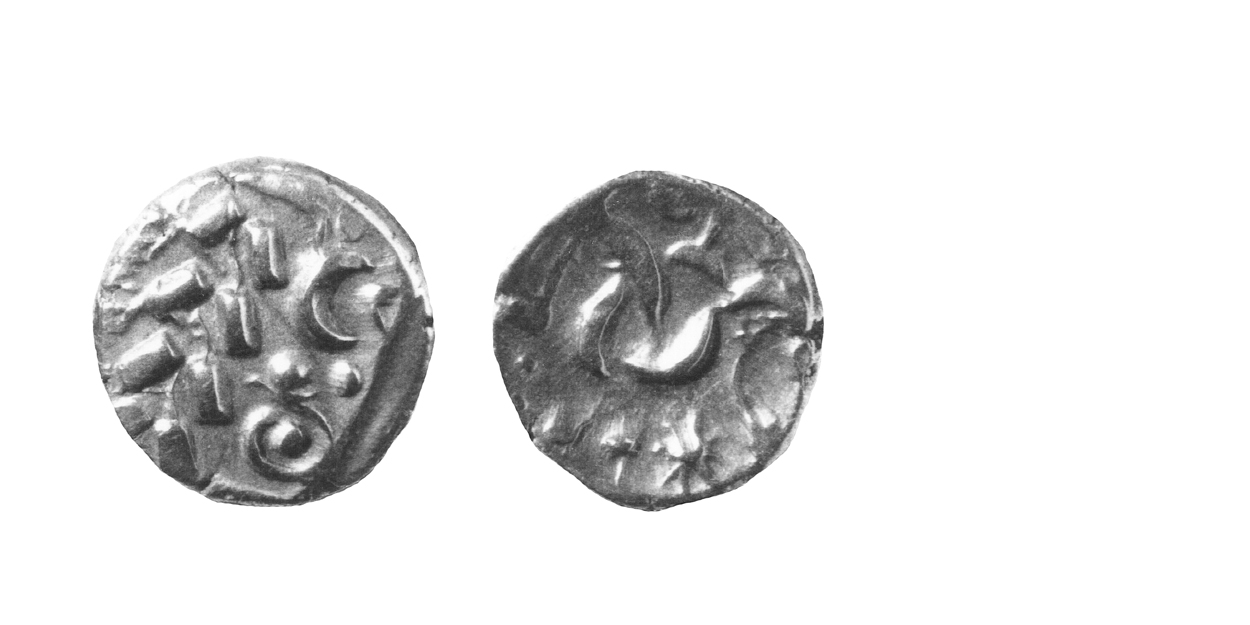
811 - 09 South Ferriby Type
ca. 45-10 B.C. Scarce
Gold Stater 5.2-5.7 gms. 18 mm
Earliest Record: Van Arsdell, 1989
OBV: Abstracted head of Apollo right
Identifying points:
1) spike with one crescent, end of spike may be bent to form two-pronged hook
2) wreath: leaves inwards
REV: Disjointed horse left
Identifying points:
1) pointed 'anchor' above horse
2) wavy-armed star below horse
CLASSIFICATION: Corieltauvian D
Notes:
- Celtic Coin Index suggests this type could be rarer than indicated, but records usually do not identify exact die variety
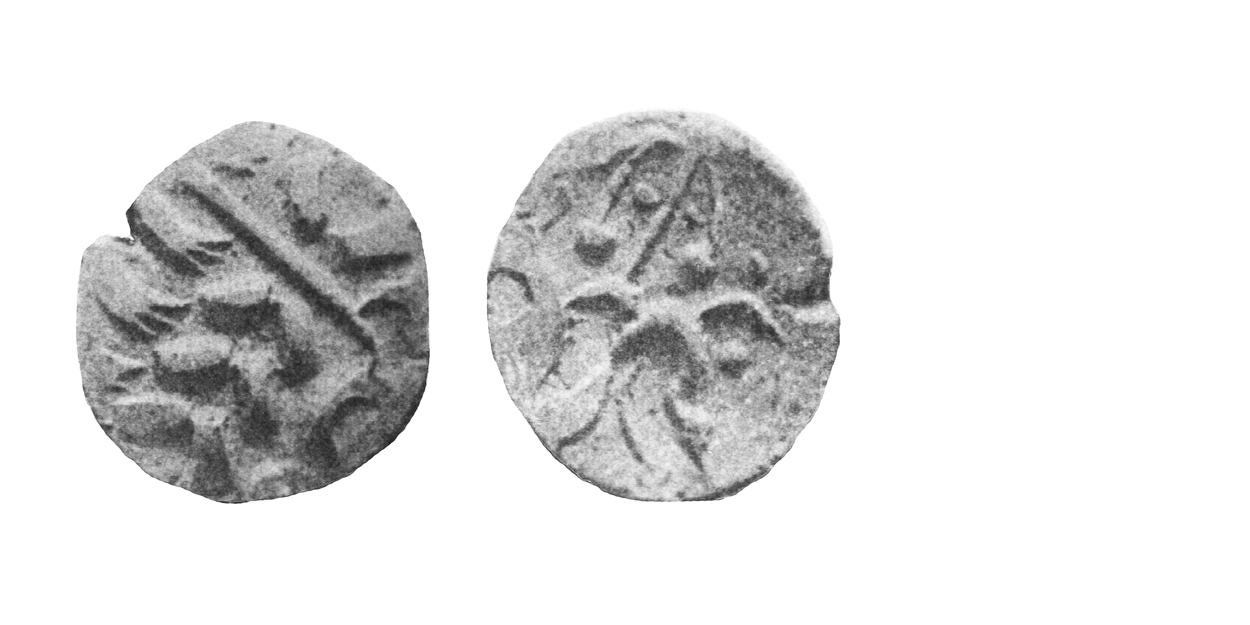
811 - 17 South Ferriby Type
ca. 45-l0 B.C. Extremely Rare
Gold Stater 5.2-5.7 gms. 20 mm
Earliest Record: Roth, 1908 (South Ferriby Hoard)
OBV: Abstracted head of Apollo right
Identifying points:
1) spike with one crescent, end of spike may be bent to form two-pronged hook
2) wreath: leaves inwards
REV: Disjointed horse left
Identifying points:
1) arms of 'anchor' droop downwards and do not encircle pellets
CLASSIFICATION: Corieltauvian D
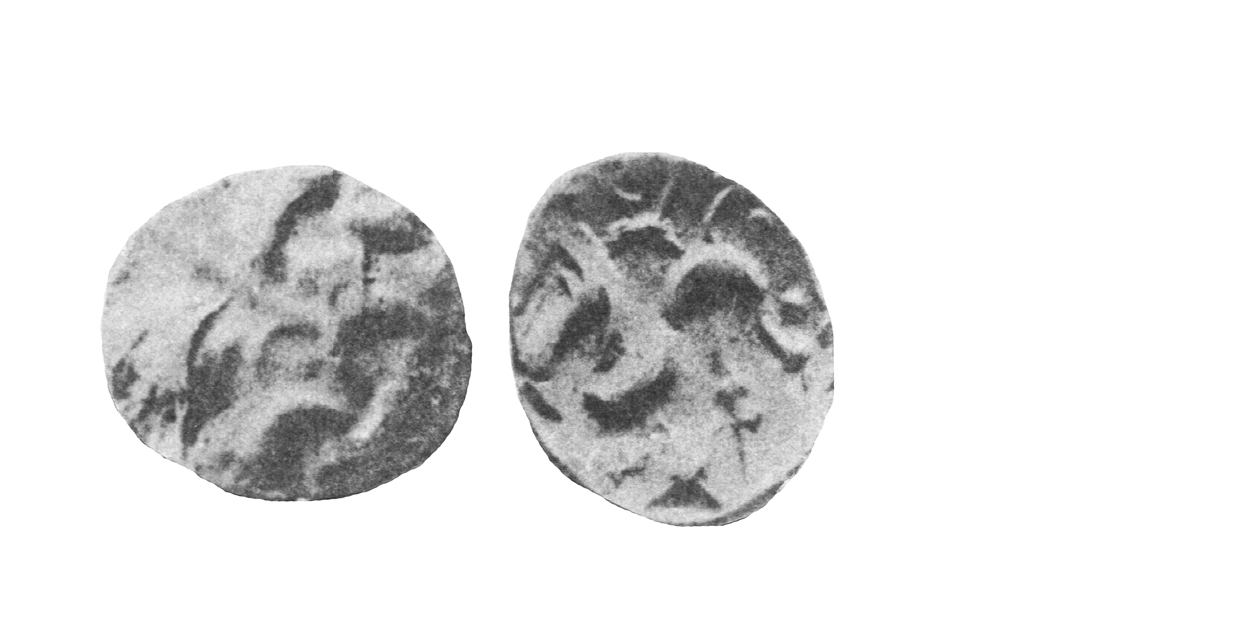
811 - 21 South Ferriby Type
ca. 45-10 B.C. Extremely Rare
Gold Stater 5.2-5.7 gms. 19 mm
Earliest Record: Roth, 1908 (South Ferriby Hoard)
OBV: Abstracted head of Apollo right
Identifying points:
1) spike with one crescent, end of spike may be bent to form two-pronged hook
2) wreath: leaves inwards
REV: Disjointed horse left
Identifying points:
1) "anchor" above horse transformed into two spirals encompassing pellets
2) six-pointed star below horse
CLASSIFICATION: Corieltauvian D
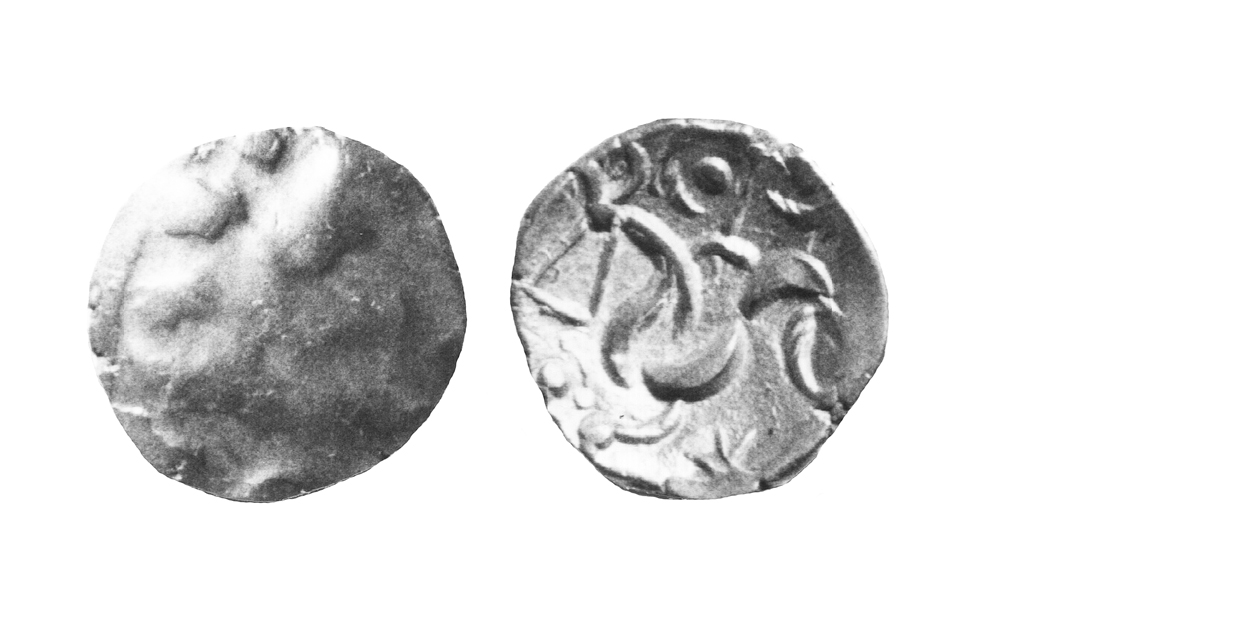
811 - 23 South Ferriby Type
ca. 45 10 B.C. Extremely Rare
Gold Stater 5.2-5.7 gms. 18 mm
Earliest Record: Van Arsdell, 1989
OBV: Abstracted head of Apollo right
Identifying points:
1) almost obliterated obverse die
REV: Disjointed horse left
Identifying points:
1) "anchor" above horse transformed into two spirals encompassing pellets
2) six-pointed star below horse
CLASSIFICATION: Corieltauvian D
NOTES:
- Obverse die of 811 - 21 used until almost completely obliterated, some examples show almost a plain obverse
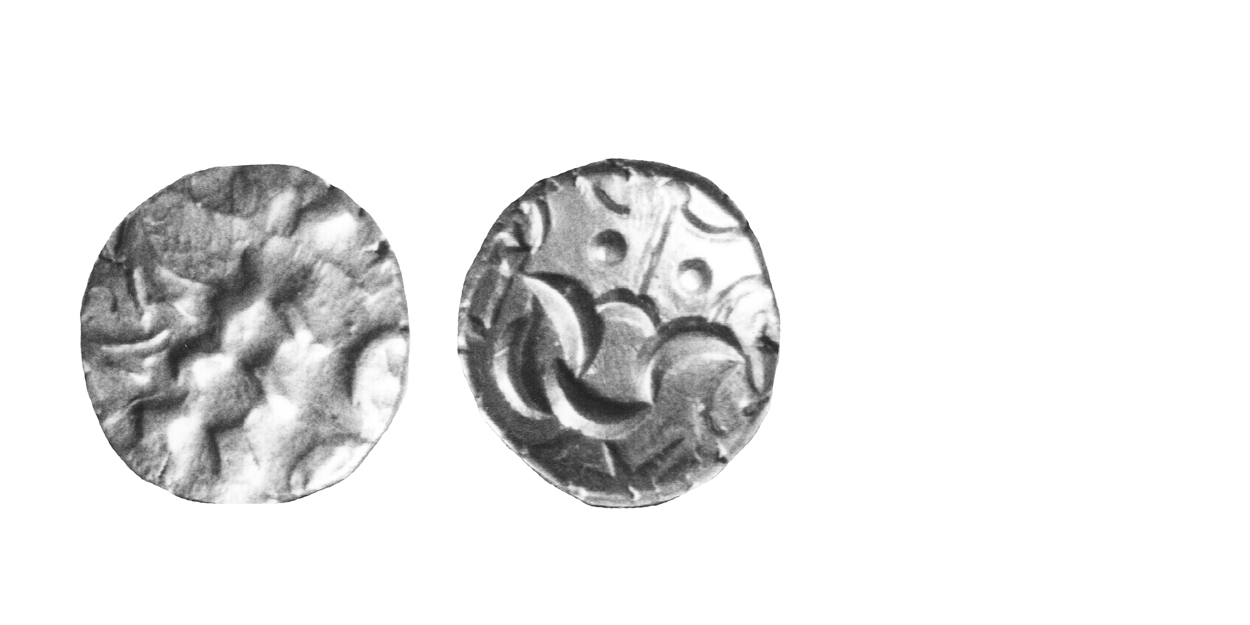
811 - 29 South Ferriby Type
ca. 45-l0 B.C. Extremely Rare
Gold Stater 5.2-5.7 gms. 18 mm
Earliest Record: Roth, 1908 (South Ferriby Hoard)
OBV: Abstracted head of Apollo right
Identifying points:
1) spike with one crescent, end of spike may be bent to form two-pronged hook
2) wreath: leaves inwards
REV: Disjointed horse left
Identifying points:
1) "anchor" has spread arms curling upwards
2) six-pointed star below horse
CLASSIFICATION: Corieltauvian D
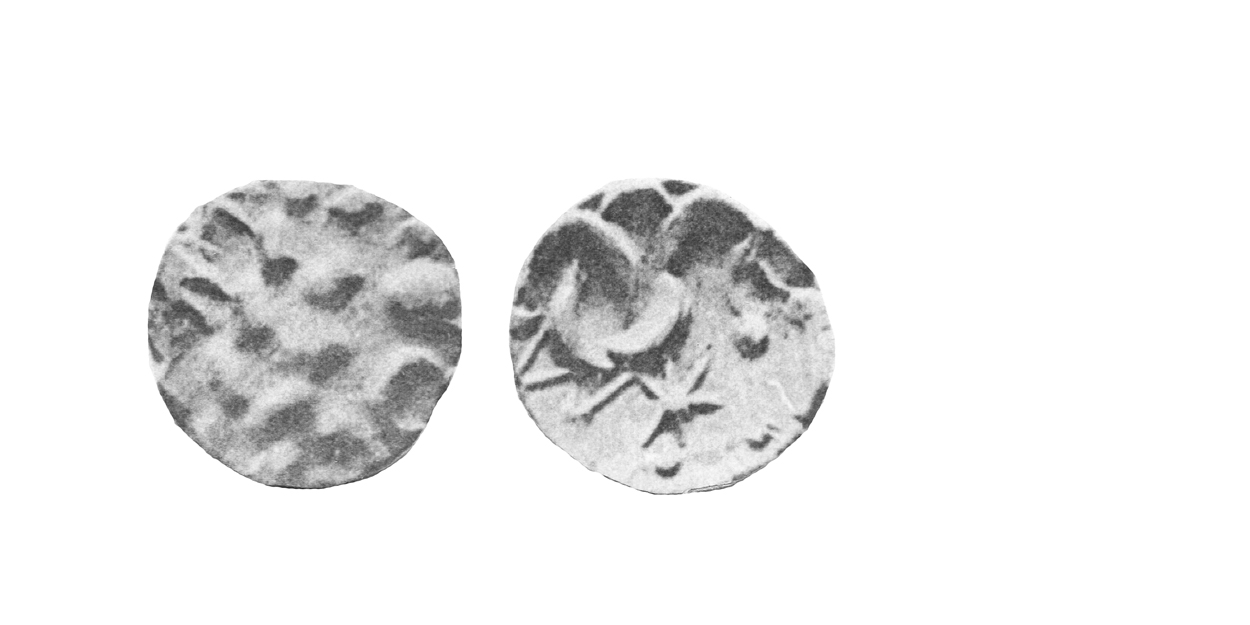
815 - 01 Transitional Type Two
ca. 45-10 B.C. Extremely Rare
Gold Stater 5.2-5.7 gms. 17 mm
Earliest Record: Roth, 1908 (South Ferriby Hoard)
OBV: Abstracted head of Apollo right
Identifying points:
1) spike with one crescent, end of spike may be bent to form two-pronged hook
2) wreath: leaves inwards
REV: Disjointed horse left
Identifying points:
1) front forelegs of horse are made up of two straight lines
2) six-pointed star below horse
CLASSIFICATION: Corieltauvian D
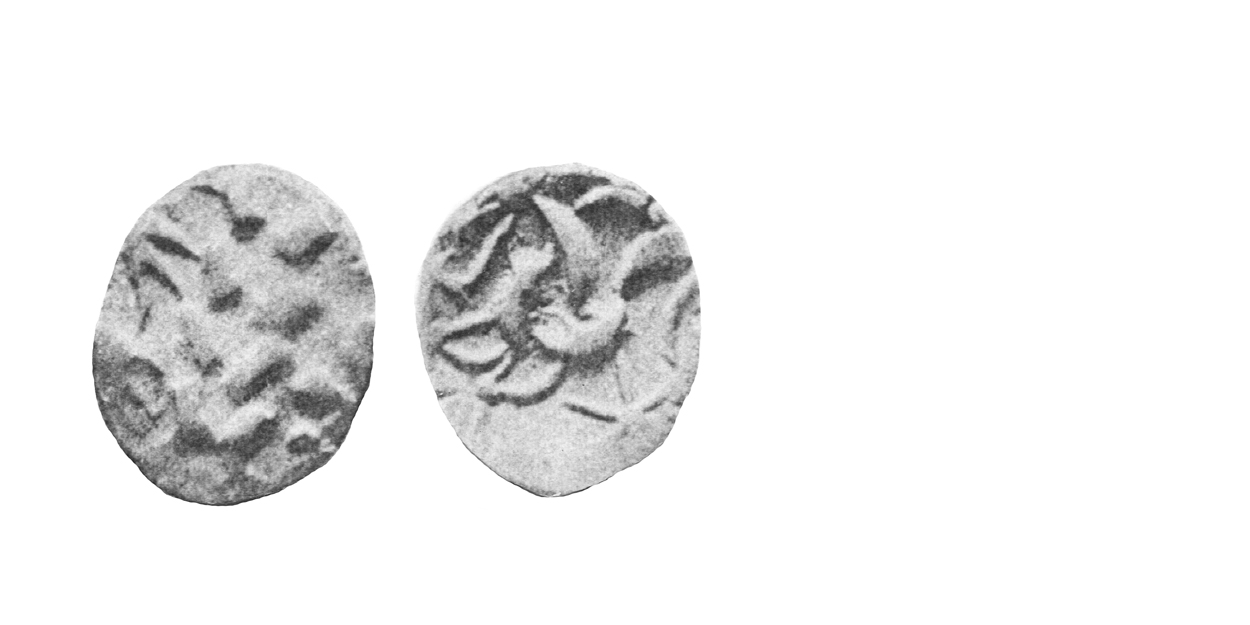
815 - 05 Transitional Type Two
ca. 45-10 B.C. Extremely Rare
Gold Stater 5.2-5.7 gms. 18 mm
Earliest Record: Roth, 1908 (South Ferriby Hoard)
OBV: Abstracted head of Apollo right
Identifying points:
1) spike with one crescent, end of spike may be bent to form two-pronged hook
2) wreath: leaves inwards
REV: Disjointed horse left
Identifying points:
1) front forelegs of horse are made up of one curved and one straight line
2) six-pointed star below horse
CLASSIFICATION: Corieltauvian D
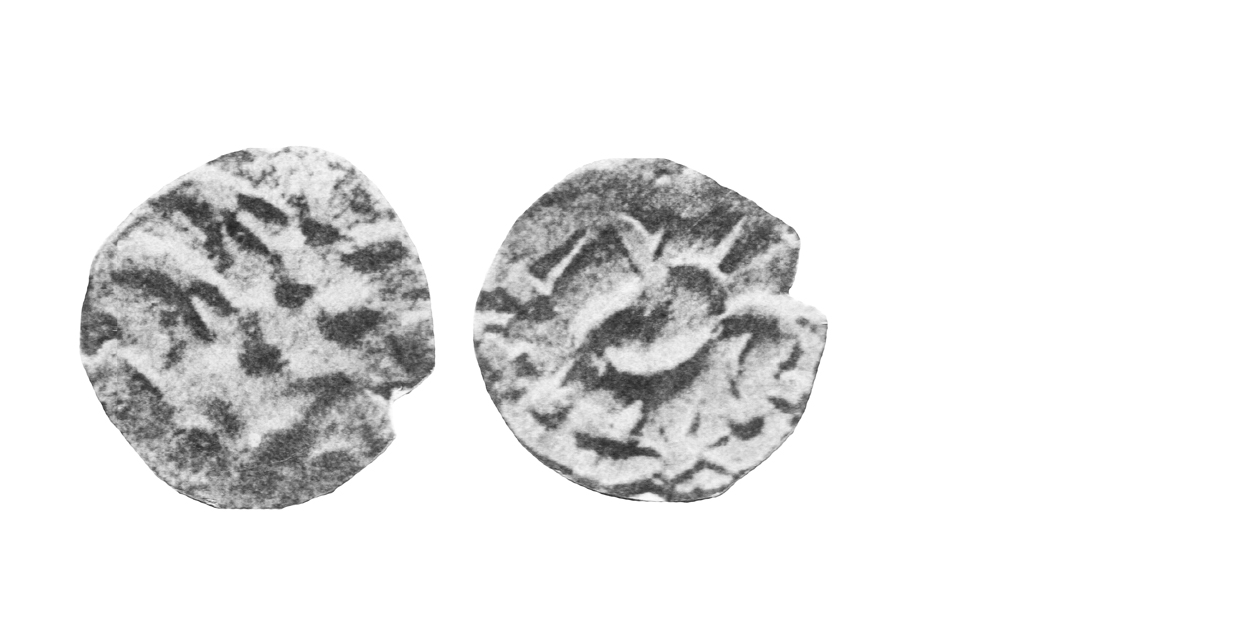
815 - 09 Transitional Type Two
ca. 45-10 B.C. Extremely Rare
Gold Stater 5.2-5.7 gms. 18 mm
Earliest Record: Roth, 1908 (South Ferriby Hoard)
OBV: Abstracted head of Apollo right
Identifying points:
1) spike with one crescent, end of spike may be bent to form two-pronged hook
2) wreath: leaves inwards
REV: Disjointed horse left
Identifying points:
1) front forelegs of horse are made up of two straight lines
2) eight-pointed star below horse
CLASSIFICATION: Corieltauvian D
The Coinage of the Corieltauvi
The Corieltauvi occupied Lincolnshire, Leicestershire, Nottinghamshire, parts of Humberside and perhaps parts of Derbyshire and South Yorkshire. The correct name of the tribe, obtained from a tile-grafitto found in 1965, is CORIELTAUVI. In the past, the tribe had been known as the "Coritani", but the new spelling has been widely accepted. The Corieltauvi, for many years, were thought to be a largely peripheral tribe, untouched by the changes transforming southern Britain. This view has been questioned by archaeological studies made after 1960. They are now considered to have been an advanced group – early to adopt the potter's wheel, for example.
Recent studies indicate the coinage was one of the earliest struck in Britain, appearing shortly after the Atrebatic/Regnan/Belgic Westerham stater. The Corieltauvi struck coins continuously until the Claudian invasion or later. The coinage has a complex system of privy marks that may have been used for die control, weight specification or perhaps identification of metallurgical content.
The coinage was at one time thought to have a Brigantian origin because several large hoards were found in the territory of that tribe. However, more comprehensive analyses of findspots identify a primarily Corieltauvian source. Recently, assertions have been made that northerly finds of late types are Brigantian, but this is a case of over-interpretation of insufficient information. Given the fluid conditions after the Claudian Invasion, the location of the Corieltauvian mint may have shifted north. Similarly, the final resting places of the latest coins would naturally tend to be in the north. The possibility that the Brigantes struck some of the later types remains. But too little information exists at this time to prove a separate Brigantian coinage.
The coinage begins around 55 B.C. with the NORTH EAST COAST TYPE, derived stylistically from the Abstract Design Type staters of the Ambiani. These coins, struck to a standard weight of 6.25 grammes, appeared in two versions. The horse on the reverse faces either right or left, and previously it was felt the change signaled a difference in the weight of the two types. However, more recent weight studies show the difference is smaller than thought. In the current catalogue, the two are listed as a single issue. The NORTH EAST COAST TYPE was replaced about 45 B.C. by the SOUTH FERRIBY TYPE, signaling a significant weight reduction to 5.7 grammes.
The South Ferriby Type and its variations display the most complex series of privy marks found on any Ancient British coinage. Cleverly-made plated forgeries are known for most types. The forgeries were produced by hammering gold foil around a bronze core prior to striking, and some of the forgeries appear to be struck from official dies. The similarity between genuine and false coins, however, may only indicate the extent of technological knowledge amongst the tribal population – the forgers may have been as expert as the mint-workers in die-cutting. The proficiency of the forgers may help explain the need for complex privy marks on the genuine coins. Alternatively, future metallurgical studies may prove the marks signal changes in the gold/silver/copper relationship instead and thus serve as assay marks.
A long series of inscribed coins followed the uninscribed, and the coinage ended with the Roman suppression of tribal coinage during the fifties A.D.
Evidence of a Celtic mint has been discovered at Old Sleaford. However it is not known if it was the only Corieltauvian mint, nor if it was the mint producing all the coins listed in this catalogue.
